Briefly: In our opinion, full (150% of the regular full position) speculative short positions in gold, silver and mining stocks are justified from the risk/reward perspective at the moment of publishing this alert.
Quite a lot happened in the precious metals last week and since we finally have the weekly closing prices and weekly volume levels we can discuss them in greater detail. There were 2 developments that appear to have particularly big implications: the confirmation of gold’s breakdown and a hidden (from most market participants) signal from the silver market.
Let’s start with the former (charts courtesy of http://stockcharts.com).
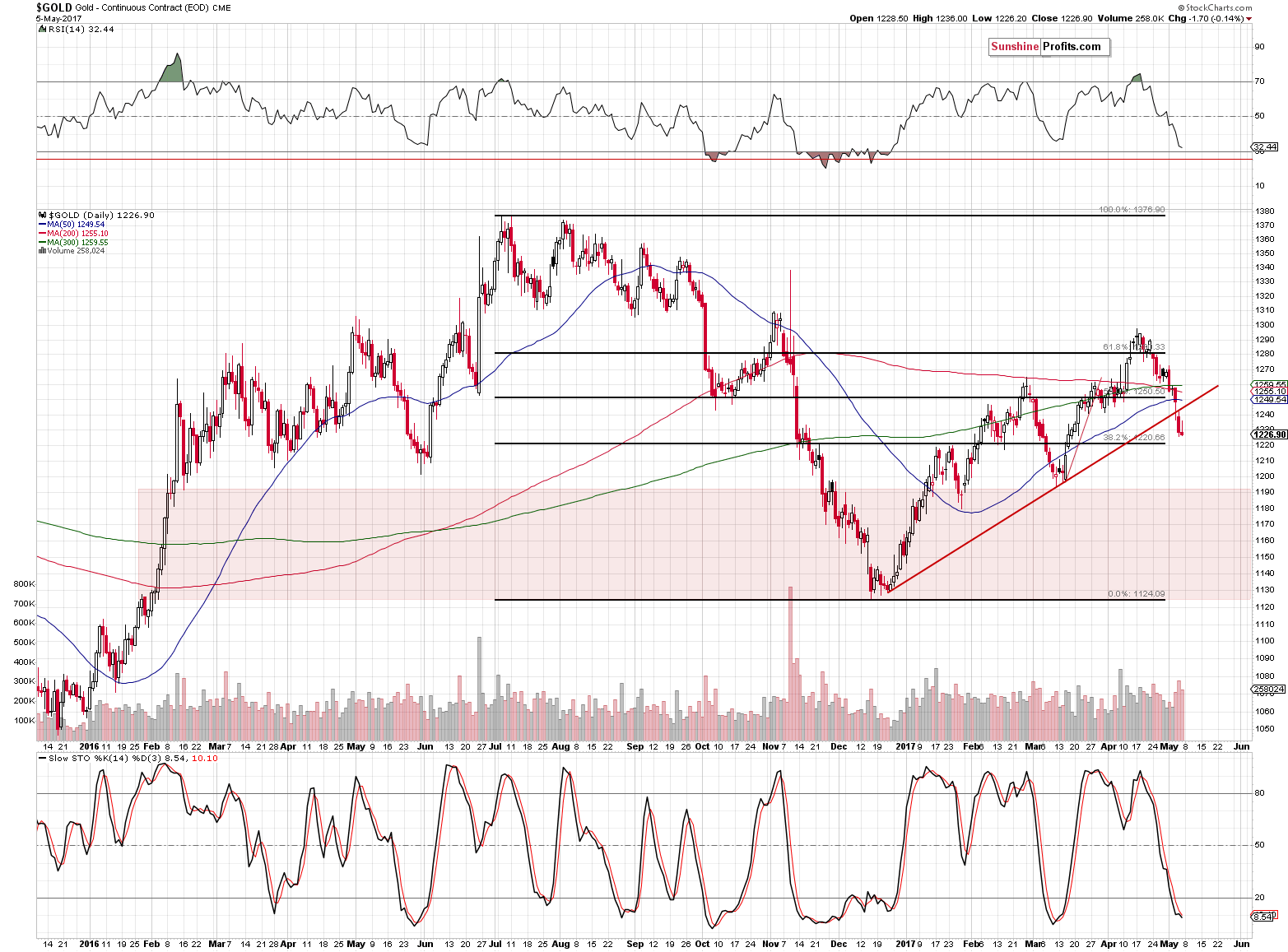
In our Friday’s alert, we wrote the following:
First of all, saying that gold was the last to break below its support line is another way of saying that it didn’t initiate a breakdown in the precious metals sector – it confirmed it. The initial breakdown took place in silver and mining stocks and since now the entire trio: gold, silver and miners are after a breakdown, the implications are most bearish.
Now, some may say that the breakdown in gold is not yet confirmed and thus that it really doesn’t count. There is some truth to it, however, since gold was the last to break lower, the implications are somewhat bearish anyway, and – most importantly – the breakdown was actually verified, in a way. The confirmation (which is necessary to determine if a move is accidental / triggered artificially or a real one that truly represents market participants’ views) can come from several things – 3 consecutive closes below a certain level, big size of the move, big size of the volume and – at times – from a weekly close below a certain level. The week is not over yet, but the move in gold was accompanied by big volume, so it was already somewhat confirmed. If gold closes today’s session (and, at the same time, the whole week) below the rising red support line ($1,242), the breakdown will be completely confirmed in our view.
Gold indeed managed to close the week below the rising support line, which indicates that lower prices of the yellow metal are to be expected. Naturally, the bearish implications extend to the rest of the precious metals sector as well.
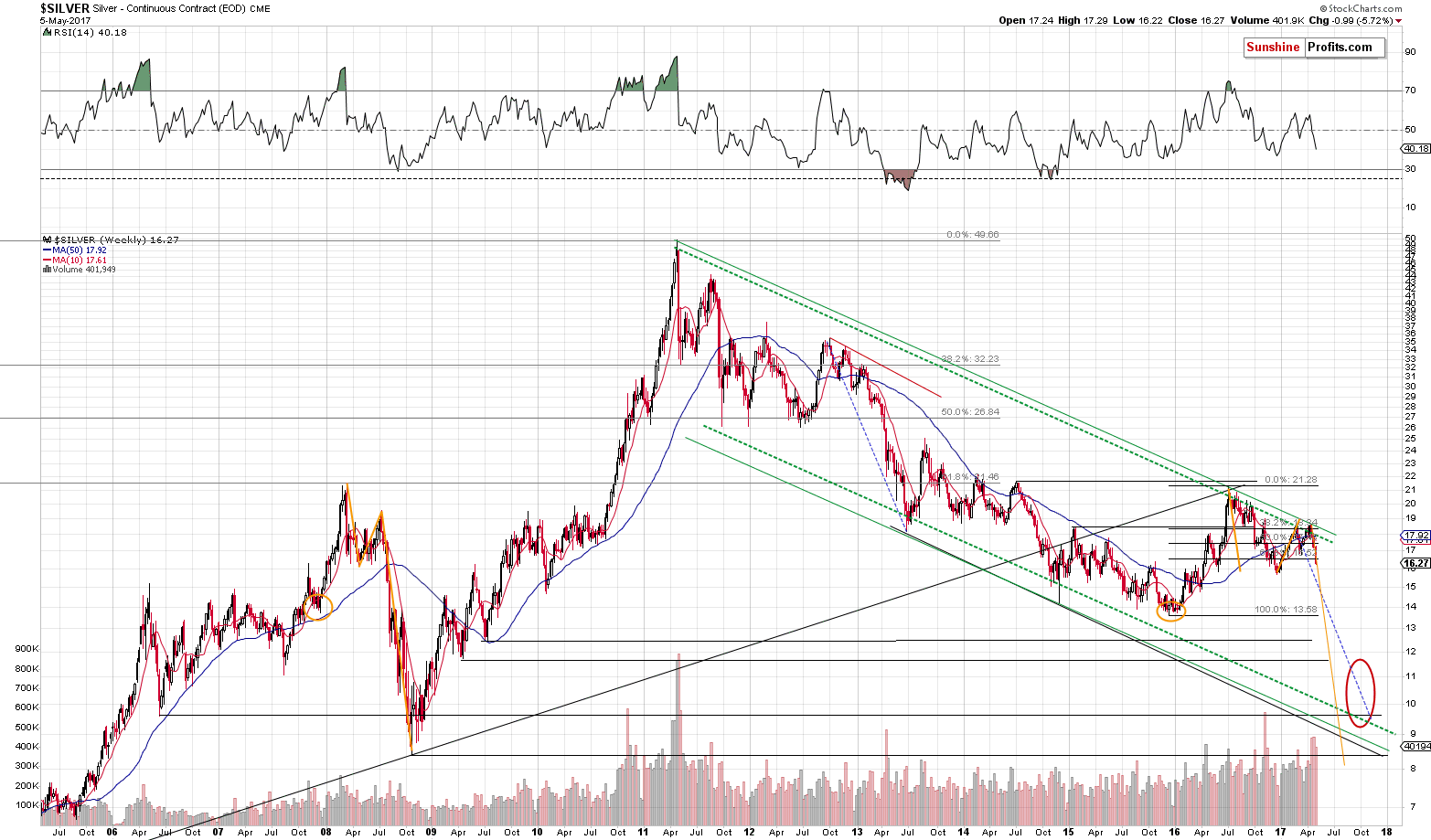
Several days ago we wrote about very bearish implications of silver’s long-term chart. The target for silver is well below the current price levels and silver declined in tune with its 2008 decline. Let’s keep in mind that the current decline seems to be less sharp, so we could see more visible (not overly significant, though) corrective upswings along the way, but the very bearish implications remain in place either way.
Now, today we can add that silver’s weekly declines took place on significant volume and that’s not a single-week event – that’s yet another week when silver declined on big volume. The implications are bearish. The RSI indicator is far from the oversold levels, so silver can decline much lower from this perspective as well.
The above is not the hidden signal that we meant in the title of today’s alert, as the volume – on its own – is a rather well-known indicator.
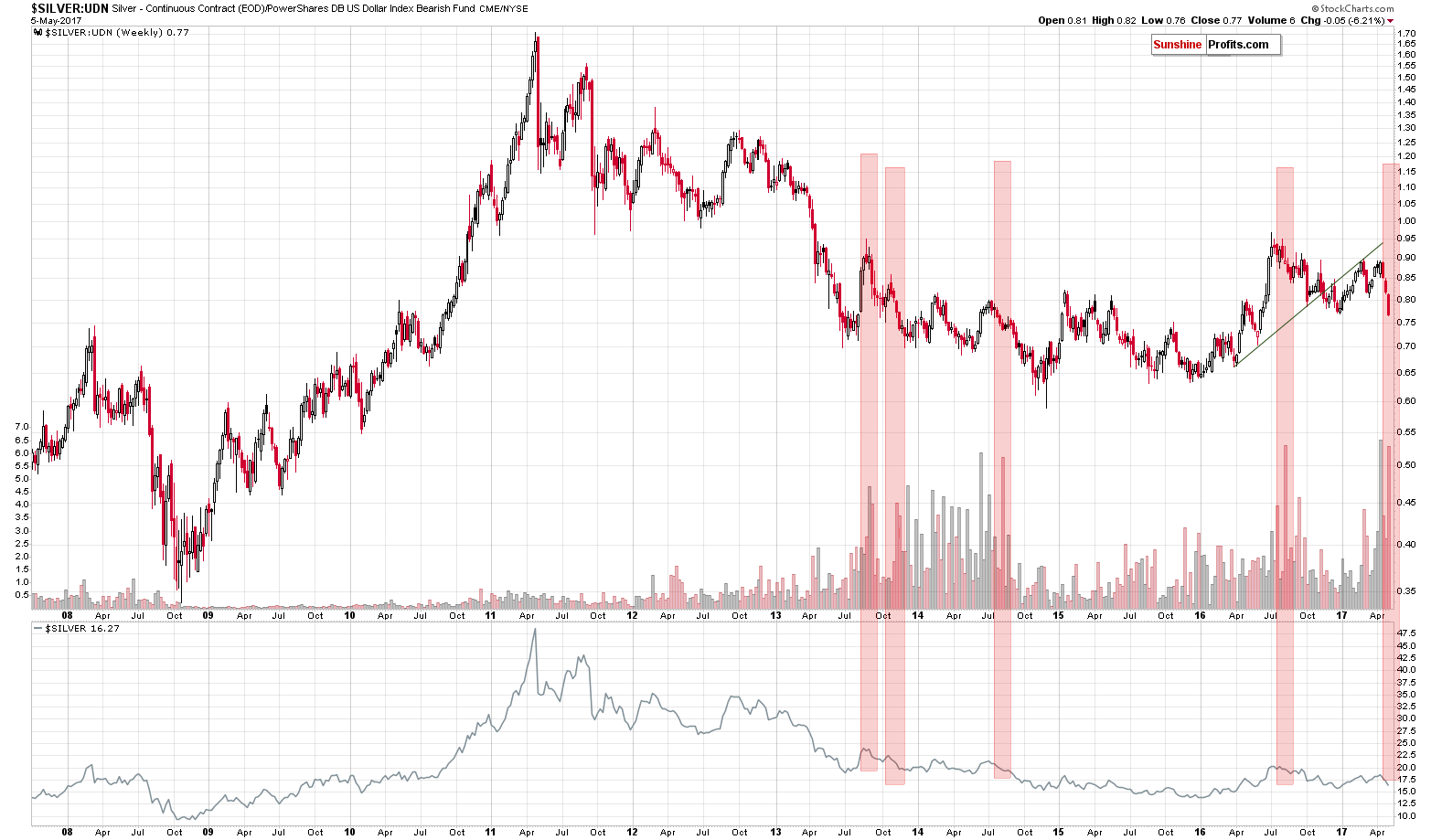
What we meant is silver’s huge weekly volume in the case of the silver-to-UDN ratio, which is not something that is widely followed. The ratio shows silver’s performance in terms of major currencies other than the U.S. dollar. The ratio is useful on its own, but its weekly volume (more precisely: the ratio of volumes) is a very reliable indicator for the medium term. Namely, a decline on huge (!) volume is a strong bearish sign for the following weeks. We marked the previous cases when the above signal was seen and silver indeed declined in the weeks that followed. We saw the signal based on the previous week, which suggests that the decline is not over – it’s just starting.
On a different note, please keep in mind that the above is a signal for the following weeks, not days, and thus a quick corrective upswing would not invalidate any of the above and it would not change the bearish medium-term implications.
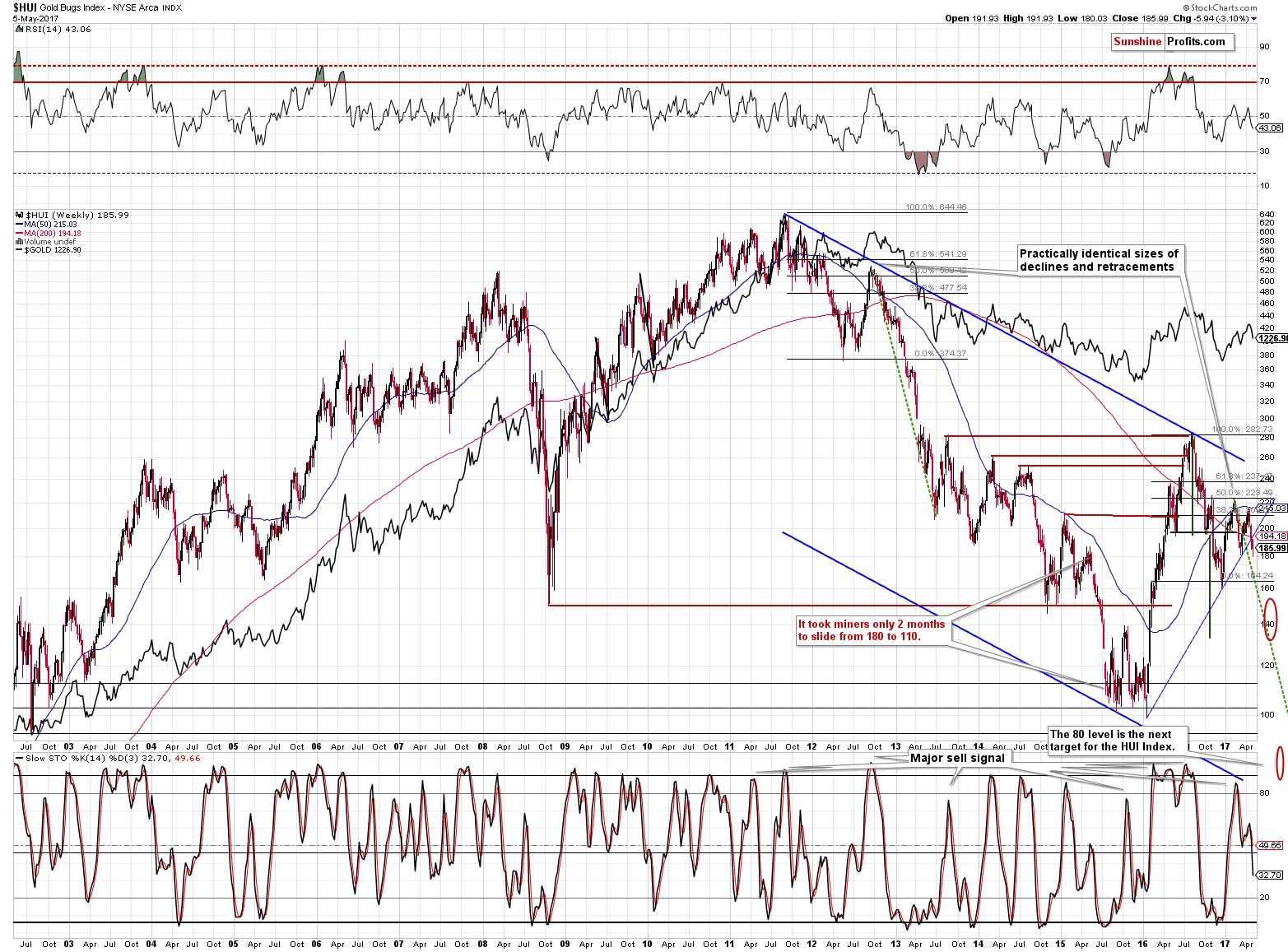
As we discussed several times in the past week, gold stocks broke below their key rising support line and the implications are bearish. We’ve seen a weekly close below this line, so the breakdown is fully confirmed and much lower prices are to be expected. It’s too early to say if this will happen shortly (or will a small corrective upswing be seen first), but it seems likely that a move to 140-150 is just around the corner.
Mining stocks rallied on Friday despite a small move lower in gold and silver, but please note that the S&P 500 Index moved to new highs on that day and this could have triggered a move higher also in mining stocks. After all, mining stocks are… stocks. Consequently, we don’t view the miners’ outperformance relative to metals as a reliable bullish sign.
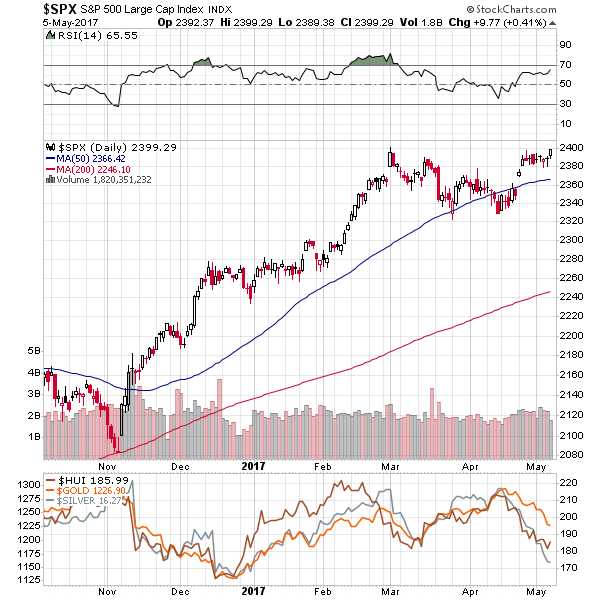
On a side note, the S&P 500 moved higher on low volume, which makes the breakout rather unreliable. A reversal and a big drop in stocks could result in the miners’ underperformance in the following days/weeks just as the move higher in the S&P was accompanied by miner’s daily strength.
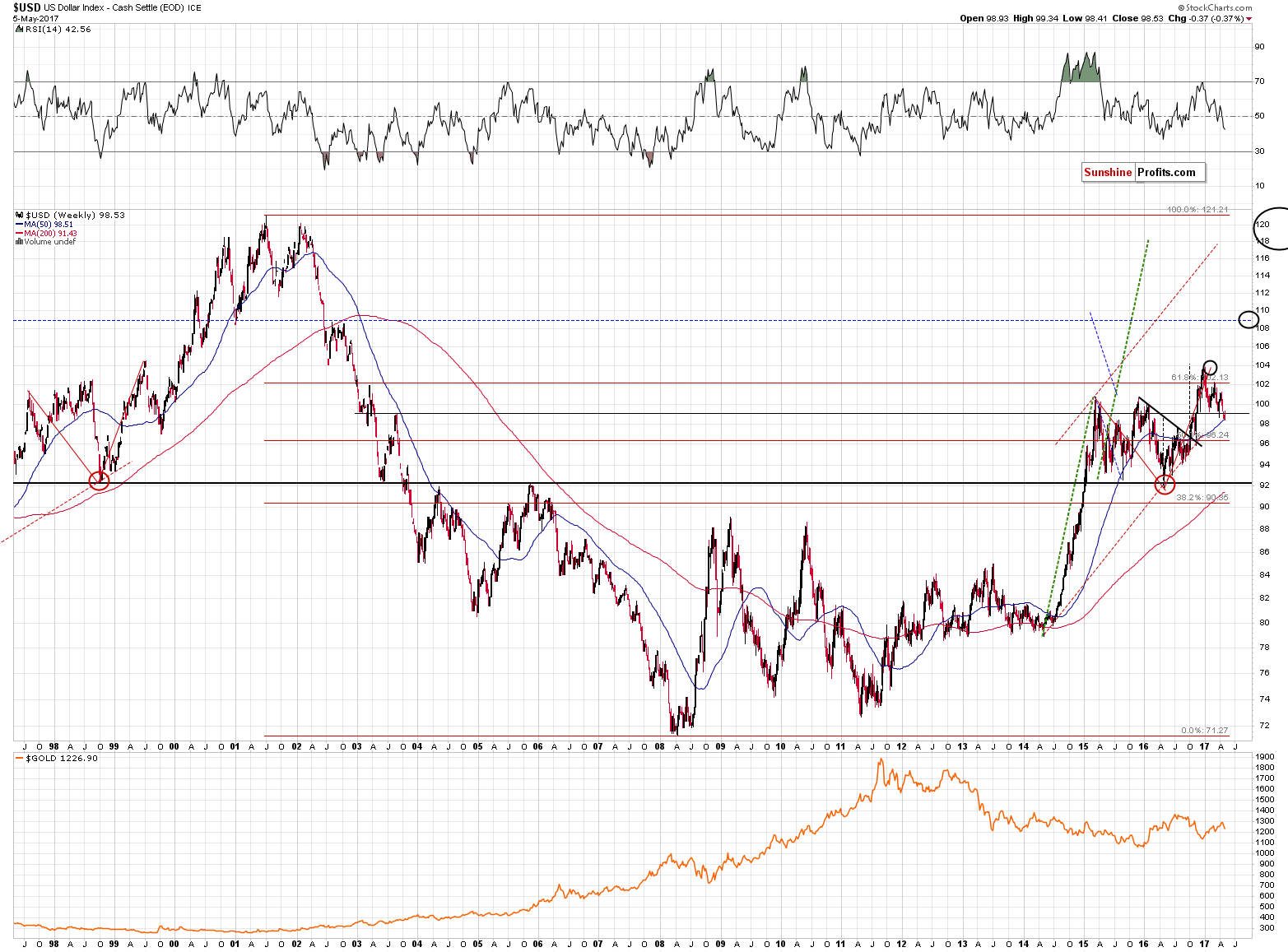
Finally, we would like to discuss the move lower in the USD Index. Did the weakness in the U.S. currency change anything regarding its long-term uptrend? We don’t think so. Another very important long-term support level was reached last week (the 50-week moving average), which stopped the declines 3 times in 2015 and served as support and resistance on other occasions.
Besides, the French elections and (low, but still) uncertainty are factors that heavily impact the EUR/USD exchange rate at this time in a more or less random way. Therefore, any technical developments such as breakouts or breakdowns should not be viewed as important and binding until a reliable confirmation is seen. For now, the analogy to the 2002 – 2003 decline remains intact.
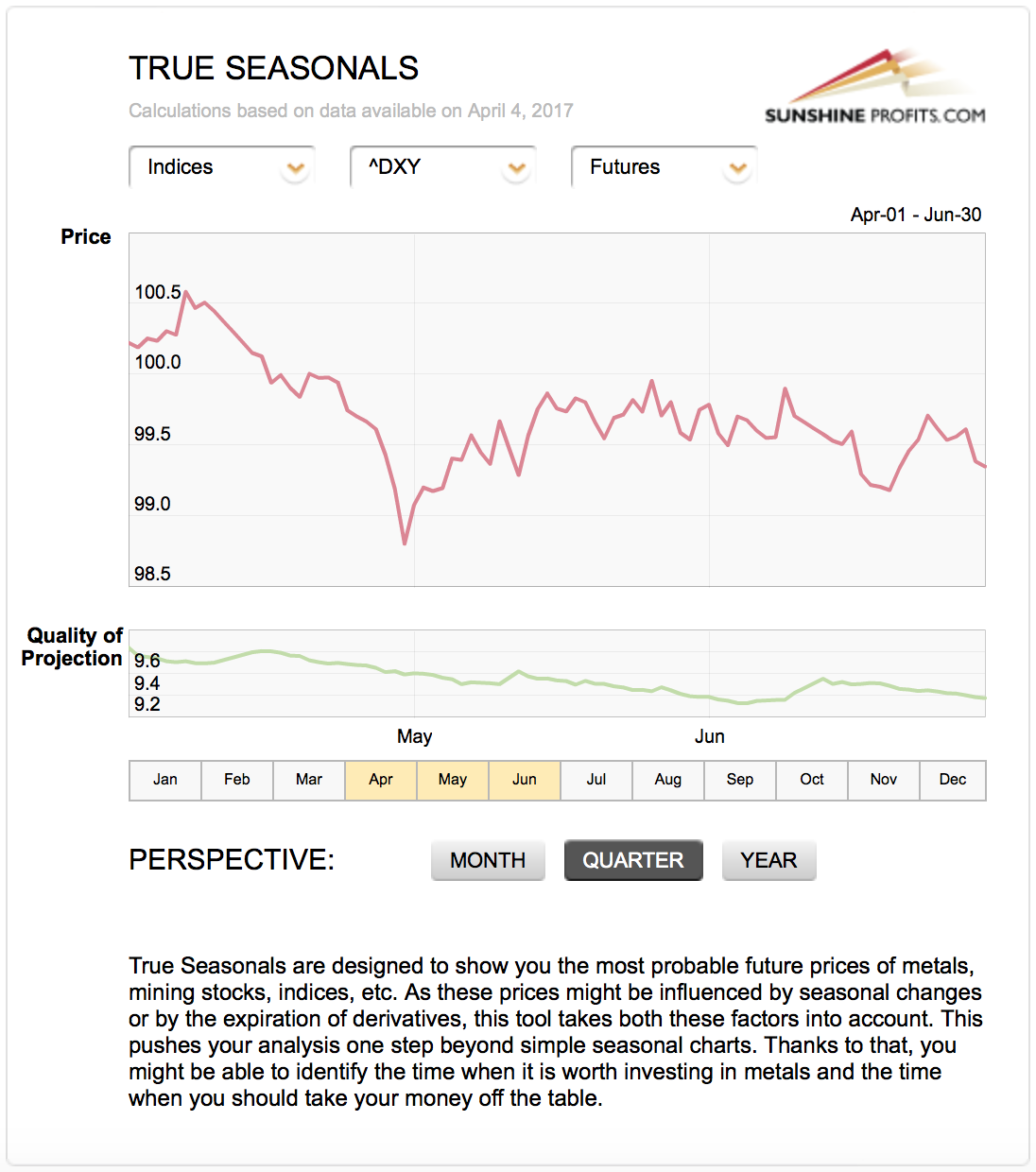
Moreover, the True Seasonal tendencies for the USD Index heavily favor a bottom in late April / early May. As the uncertainty regarding the French elections likely peaked right before them, the bottom may have already formed and higher prices are likely to follow in tune with seasonal patterns. The implications are bullish for the USD Index and bearish for the precious metals sector.
Summing up, the confirmations of breakdowns that we saw last week along with the huge volume that we saw in silver and in the silver-to-UDN ratio point to much lower prices of precious metals in the coming weeks (not necessarily days, though) and the situation in the USD Index appears to confirm the above. As always, we will keep you – our subscribers – informed.
To summarize:
Trading capital (supplementary part of the portfolio; our opinion): Short positions (150% of the full position) in gold, silver and mining stocks are justified from the risk/reward perspective with the following stop-loss orders and initial target price levels / profit-take orders:
- Gold: exit-profit-take level: $1,063; stop-loss: $1,317; initial target price for the DGLD ETN: $81.88; stop-loss for the DGLD ETN $44.57
- Silver: initial target price: $13.12; stop-loss: $19.22; initial target price for the DSLV ETN: $46.18; stop-loss for the DSLV ETN $17.93
- Mining stocks (price levels for the GDX ETF): initial target price: $9.34; stop-loss: $26.34; initial target price for the DUST ETF: $143.56; stop-loss for the DUST ETF $21.37
In case one wants to bet on junior mining stocks' prices (we do not suggest doing so – we think senior mining stocks are more predictable in the case of short-term trades – if one wants to do it anyway, we provide the details), here are the stop-loss details and initial target prices:
- GDXJ ETF: initial target price: $14.13; stop-loss: $45.31
- JDST ETF: initial target price: $417.04; stop-loss: $43.12
Long-term capital (core part of the portfolio; our opinion): No positions (in other words: cash)
Insurance capital (core part of the portfolio; our opinion): Full position
Please note that the in the trading section we describe the situation for the day that the alert is posted. In other words, it we are writing about a speculative position, it means that it is up-to-date on the day it was posted. We are also featuring the initial target prices, so that you can decide whether keeping a position on a given day is something that is in tune with your approach (some moves are too small for medium-term traders and some might appear too big for day-traders).
Plus, you might want to read why our stop-loss orders are usually relatively far from the current price.
Please note that a full position doesn’t mean using all of the capital for a given trade. You will find details on our thoughts on gold portfolio structuring in the Key Insights section on our website.
As a reminder – “initial target price” means exactly that – an “initial” one, it’s not a price level at which we suggest closing positions. If this becomes the case (like it did in the previous trade) we will refer to these levels as levels of exit orders (exactly as we’ve done previously). Stop-loss levels, however, are naturally not “initial”, but something that, in our opinion, might be entered as an order.
Since it is impossible to synchronize target prices and stop-loss levels for all the ETFs and ETNs with the main markets that we provide these levels for (gold, silver and mining stocks – the GDX ETF), the stop-loss levels and target prices for other ETNs and ETF (among other: UGLD, DGLD, USLV, DSLV, NUGT, DUST, JNUG, JDST) are provided as supplementary, and not as “final”. This means that if a stop-loss or a target level is reached for any of the “additional instruments” (DGLD for instance), but not for the “main instrument” (gold in this case), we will view positions in both gold and DGLD as still open and the stop-loss for DGLD would have to be moved lower. On the other hand, if gold moves to a stop-loss level but DGLD doesn’t, then we will view both positions (in gold and DGLD) as closed. In other words, since it’s not possible to be 100% certain that each related instrument moves to a given level when the underlying instrument does, we can’t provide levels that would be binding. The levels that we do provide are our best estimate of the levels that will correspond to the levels in the underlying assets, but it will be the underlying assets that one will need to focus on regarding the signs pointing to closing a given position or keeping it open. We might adjust the levels in the “additional instruments” without adjusting the levels in the “main instruments”, which will simply mean that we have improved our estimation of these levels, not that we changed our outlook on the markets. We are already working on a tool that would update these levels on a daily basis for the most popular ETFs, ETNs and individual mining stocks.
Our preferred ways to invest in and to trade gold along with the reasoning can be found in the how to buy gold section. Additionally, our preferred ETFs and ETNs can be found in our Gold & Silver ETF Ranking.
As always, we'll keep you - our subscribers - updated should our views on the market change. We will continue to send out Gold & Silver Trading Alerts on each trading day and we will send additional Alerts whenever appropriate.
The trading position presented above is the netted version of positions based on subjective signals (opinion) from your Editor, and the Tools and Indicators.
As a reminder, Gold & Silver Trading Alerts are posted before or on each trading day (we usually post them before the opening bell, but we don't promise doing that each day). If there's anything urgent, we will send you an additional small alert before posting the main one.
=====
Latest Free Trading Alerts:
The U.S. economy added 211,000 jobs in April. What does it mean for the gold market?
S&P 500 index gained 0.4% on Friday, as investors reacted to better-than-expected monthly jobs data release and awaited Sunday's French presidential election. Will the uptrend continue? Is holding short position still justified?
Stock Trading Alert: Stocks Are Back At Record High, But Will They Continue Higher?
=====
Hand-picked precious-metals-related links:
PRECIOUS-Gold bounces off lows hit after Macron's French election win
Gold Speculators Reduced Bullish Net Positions For 1st Time In 7 Weeks
AngloGold Ashanti profit falls after SA cost blowout
=====
In other news:
European Stocks Edge Lower After Early Morning Rally Following Macron Victory in France
Euro Weakens as Markets Look Past Macron Victory Toward Draghi
German Factory Orders Rise as Economic Boom Continues Undaunted
Bank of England walks the tightrope over interest rates
=====
Thank you.
Sincerely,
Przemyslaw Radomski, CFA
Founder, Editor-in-chief, Gold & Silver Fund Manager
Gold & Silver Trading Alerts
Forex Trading Alerts
Oil Investment Updates
Oil Trading Alerts



